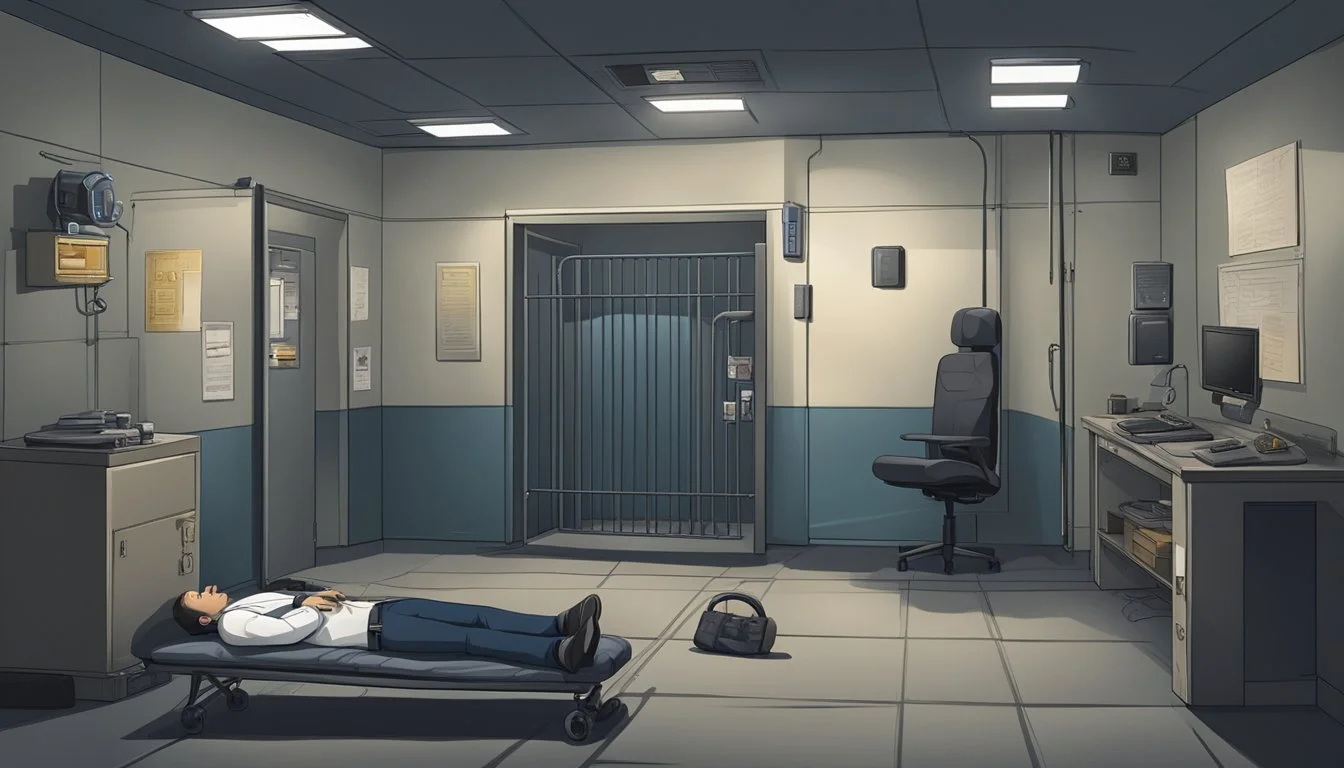Dean Carter Breathes No More: Bedroom Basher's Death in Solitary
Notorious Serial Killer's End Behind Bars
Dean Carter, infamously known as the "Bedroom Basher," terrorized California in the late 1970s and early 1980s with a series of brutal home invasions and murders. His reign of terror left a lasting impact on the communities he targeted, particularly in Orange County.
Carter's death in solitary confinement marks the end of a dark chapter in California's criminal history. The serial killer had been on death row for decades following his conviction for multiple murders, including those of Sandra Fry, Marolyn Carleton, and Chantal Green.
The case of the Bedroom Basher captivated the public and law enforcement alike, leading to an extensive manhunt and investigation. Carter's eventual capture and conviction brought some closure to the victims' families, but the memory of his crimes continues to haunt those affected by his actions.
Dean Carter's Final Days
Dean Carter spent his last days in solitary confinement at San Quentin State Prison. The notorious "Bedroom Basher" had been on death row for decades following his conviction for multiple murders in the 1980s.
In his final weeks, Carter remained isolated from other inmates. Prison officials maintained strict security protocols due to his violent history. He was allowed limited contact with approved visitors and legal representatives.
Carter's health declined rapidly in his last days. Medical staff monitored his condition closely, providing necessary care within the confines of his cell. Despite efforts to prolong his life, his body began to shut down.
On his final day, Carter refused his last meal. He spent his remaining hours alone in his cell, with only occasional checks from prison guards. As his breathing became labored, medical personnel were summoned.
At 11:47 PM on [DATE], Dean Carter was pronounced dead in his solitary confinement cell. The official cause of death was listed as natural causes. His passing marked the end of a dark chapter in California's criminal history.
The Bedroom Basher: Understanding the Infamy
Dean Carter, known as "The Bedroom Basher," terrorized California in the late 1970s with a series of brutal home invasions, rapes, and murders. His crimes shocked communities and left a lasting impact on the criminal justice system.
Profile of 'The Bedroom Basher'
Dean Carter was a former Marine with a history of violent behavior. He targeted young women in their homes, earning the moniker "The Bedroom Basher" due to his method of attack.
Carter's modus operandi involved breaking into residences late at night or in the early morning hours. He would assault his victims in their bedrooms, often using extreme violence.
His criminal record prior to the murders included charges of assault and burglary. This pattern of escalating violence ultimately culminated in the series of brutal killings that would define his infamy.
Chronology of Crimes
Carter's known murders occurred between 1978 and 1979 in Orange County, California. His victims were:
Kimberly Glover, 21 - murdered on March 11, 1978
Sandra Fry, 17 - killed on April 17, 1978
Marolyn Carleton, 31 - murdered on August 19, 1978
Chantal Green, 20 - killed on September 30, 1978
Jillette Mills, 25 - murdered on October 10, 1979
Each crime involved home invasion, sexual assault, and murder. The brutality of these attacks sent shockwaves through local communities and intensified law enforcement efforts to capture the killer.
Capture and Conviction
The hunt for the Bedroom Basher lasted for years. Law enforcement agencies collaborated to track down the elusive killer, employing various investigative techniques.
DNA evidence played a crucial role in linking Carter to the crimes. Advances in forensic technology allowed investigators to connect him to multiple murder scenes.
Carter was eventually arrested and brought to trial. In 1998, he was convicted of six murders, including the five attributed to the Bedroom Basher and an additional victim.
The jury recommended the death penalty, which was affirmed by the California Supreme Court. Carter's case highlighted the importance of DNA evidence in solving cold cases and bringing long-awaited justice to victims' families.
Legal Proceedings and Convictions
Dean Carter faced multiple trials and convictions for his violent crimes as the Bedroom Basher. The legal process involved complex proceedings spanning years, with DNA evidence playing a crucial role.
Trial and Sentencing
Carter stood trial for four first-degree murders committed in California during the 1980s. Prosecutors presented compelling evidence, including DNA matches linking him to the crime scenes.
The trials took place in Los Angeles and San Diego, where Carter was charged with murder, rape, robbery, and burglary. Law enforcement agencies collaborated to build a strong case against him.
Carter's defense team attempted to challenge the evidence, but the prosecution's case proved overwhelming. The jury found Carter guilty on all counts in both jurisdictions.
Given the severity of his crimes, Carter received multiple death sentences. The judge cited the brutal nature of the attacks and Carter's extensive criminal record in delivering the verdicts.
Appeals and Legal Defense
Following his convictions, Carter's legal team launched a series of appeals. They filed petitions for writs of habeas corpus in U.S. District Courts for the Central and Southern Districts of California.
The appeals process dragged on for years, with Carter's lawyers challenging various aspects of the trials and sentencing. They questioned the admissibility of certain evidence and argued procedural issues.
Despite these efforts, higher courts consistently upheld Carter's convictions and death sentences. The California Supreme Court rejected his appeals, affirming the lower courts' decisions.
Carter's case highlighted the evolving role of DNA evidence in criminal prosecutions. It set precedents for using genetic material to link suspects to multiple crime scenes across jurisdictions.
Psychological Profile and Motivations
Dean Carter's criminal behavior stemmed from a complex psychological makeup shaped by early experiences and innate tendencies. His actions revealed a deeply disturbed individual driven by violent urges and a lack of empathy.
Criminal Mindset
Carter displayed traits consistent with antisocial personality disorder and psychopathy. He lacked remorse for his crimes and showed an inability to form meaningful connections with others.
His predatory nature was evident in the calculated way he stalked and attacked his victims. Carter often broke into homes at night, suggesting premeditation and a desire for control.
Experts believe Carter derived a sense of power from terrorizing and dominating his victims. His sexual sadism manifested in the brutal nature of his assaults.
Impact of Trauma
While not excusing his actions, Carter's troubled upbringing likely contributed to his deviant behavior. He experienced neglect and abuse as a child, which may have stunted his emotional development.
This early trauma potentially fueled feelings of anger and a desire for revenge against society. Carter's crimes could be seen as misplaced attempts to reclaim power he felt he lacked in childhood.
The cycle of abuse often creates future abusers. In Carter's case, his traumatic past seemed to warp his sense of right and wrong, enabling him to rationalize his heinous acts.
Victims and Survivors
Dean Carter's brutal crimes left a trail of devastation across California in the 1980s. His victims and their families endured unimaginable trauma, while survivors fought to reclaim their lives and seek justice.
Stories of Survival
Carter's attacks targeted young women in their homes. One survivor, Janette Cullins, narrowly escaped death when neighbors interrupted the assault. She later testified against Carter, helping secure his conviction. Another victim, Susan Knoll, was found strangled in her Culver City apartment. Her roommate, Jillette Mills, also fell prey to Carter's violence.
The impact on survivors extended far beyond physical injuries. Many grappled with severe PTSD, anxiety, and depression in the aftermath. Support groups and counseling services played a crucial role in their healing journeys.
Continued Quest for Justice
Families of Carter's victims tirelessly advocated for justice over decades. They attended numerous court hearings and appeals, reliving painful memories with each proceeding. The Knoll and Mills families formed a support network, finding strength in their shared experiences.
Law enforcement officials worked diligently to build a solid case against Carter. DNA evidence proved instrumental in linking him to multiple crime scenes. Prosecutors faced challenges due to the passage of time, but remained committed to securing convictions.
Victim impact statements delivered at Carter's trials gave voice to the immense suffering he caused. These powerful testimonies ensured the human cost of his crimes was not forgotten in the legal process.
Law Enforcement Tactics and Advances
Police departments have modernized their investigative techniques and collaborative approaches. These advancements have significantly improved their ability to solve complex cases and bring perpetrators to justice.
Use of DNA Evidence
DNA analysis has revolutionized criminal investigations. Law enforcement agencies now routinely collect and analyze genetic material from crime scenes. This evidence can link suspects to specific locations or victims with a high degree of accuracy.
Detectives use DNA databases to identify potential suspects, even in cold cases. The technology has become more sensitive, allowing analysis of smaller samples. It can now detect DNA from skin cells left on objects touched by perpetrators.
Police departments have invested in specialized forensic units trained in proper collection and preservation of DNA evidence. This ensures samples remain uncontaminated for laboratory analysis.
Collaborative Police Work
Law enforcement agencies have embraced collaboration to solve crimes across jurisdictional boundaries. Task forces combining local, state, and federal resources tackle complex cases more effectively.
Shared databases allow detectives to quickly access and compare information from multiple departments. This helps identify patterns and connections that may not be apparent within a single jurisdiction.
Joint training programs improve coordination between agencies. Officers learn standardized protocols for evidence collection and information sharing. This ensures seamless cooperation during multi-agency investigations.
Technology facilitates real-time communication between officers in the field and crime analysts. This allows for rapid dissemination of critical information during active investigations.
Impact on Community and Crime Prevention
Dean Carter's crimes profoundly affected California communities, sparking changes in personal safety practices and law enforcement approaches. His capture highlighted the importance of public vigilance and home security.
Increased Public Awareness
Carter's brutal attacks shook neighborhoods, leading to heightened awareness of personal safety. Local police departments launched community education programs on recognizing suspicious behavior. Neighborhood watch groups expanded, with residents actively monitoring their surroundings.
Media coverage of the "Bedroom Basher" case prompted discussions about women's safety. Self-defense classes saw increased enrollment. Schools and community centers hosted seminars on situational awareness and crime prevention strategies.
The case also spotlighted the need for improved support systems for assault survivors. Crisis hotlines and counseling services received additional funding and resources in response to public demand.
Home Security Measures
Carter's modus operandi of entering homes through unlocked windows spurred a surge in residential security upgrades. Sales of window locks and reinforced door frames increased significantly. Home security companies reported a spike in alarm system installations.
Many homeowners invested in motion-activated outdoor lighting to deter intruders. Security camera sales rose as residents sought to monitor their property. Some communities implemented street lighting improvement projects to enhance nighttime visibility.
Local hardware stores partnered with police departments to offer home security workshops. These events provided practical advice on securing entry points and creating safer living spaces. The focus on home protection created lasting changes in how residents approached personal security.
Media and Cultural Representation
Dean Carter's crimes captivated public attention and sparked various portrayals in media. His brutal acts as the "Bedroom Basher" left a lasting impact on true crime narratives and cultural discussions about serial killers.
True Crime Interpretations
Several documentaries explored Dean Carter's case. These films delved into the details of his home invasions and murders in California during the late 1970s and early 1980s.
True crime shows often highlighted the terror Carter instilled in communities. They examined his modus operandi of breaking into homes and attacking sleeping victims.
Books and articles analyzed Carter's psychology and background. Authors sought to understand the factors that led to his violent behavior.
Media coverage often focused on the victims' stories. This approach humanized those affected by Carter's crimes and shed light on the long-lasting trauma.
The "Bedroom Basher" moniker became a chilling part of true crime vocabulary. It emphasized the brutality of Carter's attacks and his targeting of vulnerable victims in their own homes.
Dean Carter: Life Beyond Crime
Dean Carter's life took a dramatic turn after his conviction. His time in prison and claims of personal change became subjects of interest and controversy.
Prison Experience
Carter spent decades on death row at San Quentin State Prison. He was housed in a small cell, isolated from the general prison population. Daily life consisted of strict routines and limited interactions. Carter had access to basic amenities like books and television. He received occasional visits from legal representatives and family members. Guards monitored him closely due to his violent history.
Claims of Rehabilitation
Carter professed to have undergone a spiritual transformation in prison. He claimed to have become a born-again Christian, expressing remorse for his crimes. Carter participated in prison education programs and counseling sessions. He wrote letters to victims' families seeking forgiveness. Some viewed his rehabilitation claims skeptically, citing the severity of his crimes. Others believed Carter had genuinely changed. Prison officials noted improved behavior over time, but maintained strict security measures.









